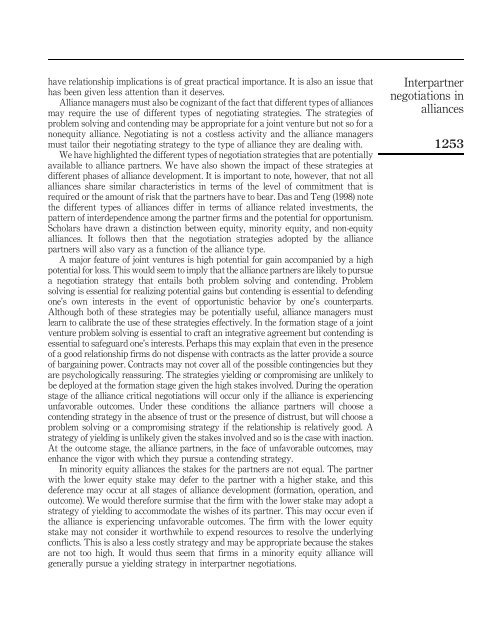alliances a strategic framework
Download - zicklin : school of business - CUNY
Download - zicklin : school of business - CUNY
- No tags were found...
Create successful ePaper yourself
Turn your PDF publications into a flip-book with our unique Google optimized e-Paper software.
have relationship implications is of great practical importance. It is also an issue that<br />
has been given less attention than it deserves.<br />
Alliance managers must also be cognizant of the fact that different types of <strong>alliances</strong><br />
may require the use of different types of negotiating strategies. The strategies of<br />
problem solving and contending may be appropriate for a joint venture but not so for a<br />
nonequity alliance. Negotiating is not a costless activity and the alliance managers<br />
must tailor their negotiating strategy to the type of alliance they are dealing with.<br />
We have highlighted the different types of negotiation strategies that are potentially<br />
available to alliance partners. We have also shown the impact of these strategies at<br />
different phases of alliance development. It is important to note, however, that not all<br />
<strong>alliances</strong> share similar characteristics in terms of the level of commitment that is<br />
required or the amount of risk that the partners have to bear. Das and Teng (1998) note<br />
the different types of <strong>alliances</strong> differ in terms of alliance related investments, the<br />
pattern of interdependence among the partner firms and the potential for opportunism.<br />
Scholars have drawn a distinction between equity, minority equity, and non-equity<br />
<strong>alliances</strong>. It follows then that the negotiation strategies adopted by the alliance<br />
partners will also vary as a function of the alliance type.<br />
A major feature of joint ventures is high potential for gain accompanied by a high<br />
potential for loss. This would seem to imply that the alliance partners are likely to pursue<br />
a negotiation strategy that entails both problem solving and contending. Problem<br />
solving is essential for realizing potential gains but contending is essential to defending<br />
one’s own interests in the event of opportunistic behavior by one’s counterparts.<br />
Although both of these strategies may be potentially useful, alliance managers must<br />
learn to calibrate the use of these strategies effectively. In the formation stage of a joint<br />
venture problem solving is essential to craft an integrative agreement but contending is<br />
essential to safeguard one’s interests. Perhaps this may explain that even in the presence<br />
of a good relationship firms do not dispense with contracts as the latter provide a source<br />
of bargaining power. Contracts may not cover all of the possible contingencies but they<br />
are psychologically reassuring. The strategies yielding or compromising are unlikely to<br />
be deployed at the formation stage given the high stakes involved. During the operation<br />
stage of the alliance critical negotiations will occur only if the alliance is experiencing<br />
unfavorable outcomes. Under these conditions the alliance partners will choose a<br />
contending strategy in the absence of trust or the presence of distrust, but will choose a<br />
problem solving or a compromising strategy if the relationship is relatively good. A<br />
strategy of yielding is unlikely given the stakes involved and so is the case with inaction.<br />
At the outcome stage, the alliance partners, in the face of unfavorable outcomes, may<br />
enhance the vigor with which they pursue a contending strategy.<br />
In minority equity <strong>alliances</strong> the stakes for the partners are not equal. The partner<br />
with the lower equity stake may defer to the partner with a higher stake, and this<br />
deference may occur at all stages of alliance development (formation, operation, and<br />
outcome). We would therefore surmise that the firm with the lower stake may adopt a<br />
strategy of yielding to accommodate the wishes of its partner. This may occur even if<br />
the alliance is experiencing unfavorable outcomes. The firm with the lower equity<br />
stake may not consider it worthwhile to expend resources to resolve the underlying<br />
conflicts. This is also a less costly strategy and may be appropriate because the stakes<br />
are not too high. It would thus seem that firms in a minority equity alliance will<br />
generally pursue a yielding strategy in interpartner negotiations.<br />
Interpartner<br />
negotiations in<br />
<strong>alliances</strong><br />
1253
















